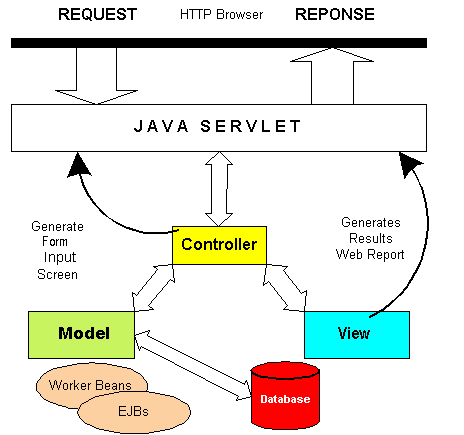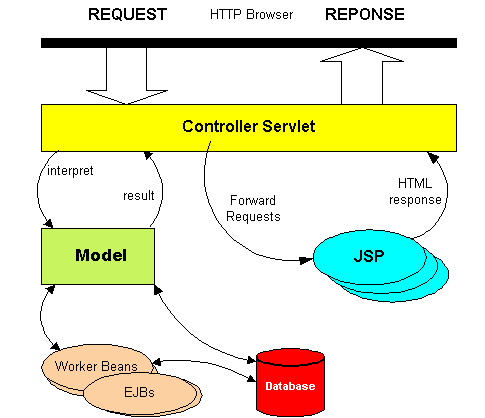Table of Contents
Note
If you find this EDG documentation helpful please consider DONATING! to keep the doc alive and current.
| Maintainer:David Lloyd |
Flexibility in large component based systems raise questions on how to organize a project for easy development and maintenance while protecting your data and reputation, especially from new developers and unwitting users. The answer is in using the Model, View, Control (MVC) architecture. An architecture such as MVC is a design pattern that describes a recurring problem and its solution where the solution is never exactly the same for every recurrence.
To use the Model-View-Controller MVC paradigm effectively you must understand the division of labor within the MVC triad. You also must understand how the three parts of the triad communicate with each other and with other active views and controllers; the sharing of a single mouse, keybord and display screen among several applications demands communication and cooperation. To make the best use of the MVC paradigm you need also to learn about the available subclasses of View and Controller which provide ready made starting points for your applications.
In the MVC design pattern , application flow is mediated by a central controller. The controller delegates requests to an appropriate handler. The controller is the means by which the user interacts with the web application. The controller is responsible for the input to the model. A pure GUI controller accepts input from the user and instructs the model and viewport to perform action based on that input. If an invalid input is sent to the controller from the view, the model informs the controller to direct the view that error occurred and to tell it to try again.
A web application controller can be thought of as specialised view since it has a visual aspect. It would be actually be one or more HTML forms in a web application and therefore the model can also dictate what the controller should display as input. The controller would produce HTML to allow the user input a query to the web application. The controller would add the necessary parameterisation of the individual form element so that the Servlet can observe the input. This is different from a GUI, actually back-to-front, where the controller is waiting and acting on event-driven input from mouse or graphics tablet.
The controller adapts the request to the model. The model represents, or encapsulates, an application's business logic or state. It captures not only the state of a process or system, but also how the system works. It notifies any observer when any of the data has changed. The model would execute the database query for example.
Control is then usually forwarded back through the controller to the appropriate view. The view is responsible for the output of the model. A pure GUI view attaches to a model and renders its contents to the display surface. In addition, when the model changes, the viewport automatically redraws the affected part of the image to reflect those changes. A web application view just transforms the state of the model into readable HTML. The forwarding can be implemented by a lookup in a mapping in either a database or a file. This provides a loose coupling between the model and the view, which can make an application much easier to write and maintain.

By dividing the web application into a Model, View, and Controller we can, therefore, separate the presentation from the business logic. If the MVC architecture is designed purely, then a Model can have multiple views and controllers. Also note that the model does not necessarily have to be a Java Servlet. In fact a single Java Servlet can offer multiple models. The Java Servlet is where you would place security login, user authentication and database pooling for example. After all these latter have nothing to do with the business logic of the web application or the presentation.
Now that we have a convenient architucture to separate the view, how can we leverage that? Java Server Pages (JSP) becomes more interesting because the HTML content can be separated from the Java business objects. JSP can also make use of Java Beans. The business logic could be placed inside Java Beans. If the design is architected correctly, a Web Designer could work with HTML on the JSP site without interfering with the Java developer.
The Model/View/Controller architecture also works with JSP. In fact it makes the initial implementation a little easier to write. The controller object is master Servlet. Every request goes through the controller who retrieves the necessary model object. The model may interact with other business entities such as databases or Enterprise Java Beans (EJB). The model object sends the output results back to the controller. The controller takes the results and places it inside the web browser session and forwards a redirect request to a particular Java Server Page. The JSP, in the case, is the view.

The controller has to bind a model and a view, but it could be any model and associated any view. Therein lies the flexibility and perhaps an insight to developing a very advanced dynamic controller that associates models to a view.
The prior sections have concentrated on their being one controller, one model, and one view. In practice, multiple controllers may exist - but only one controls a section of the application at a time. For example, the administrator's functions may be controlled by one controller and the main logic controlled by another. Since only one controller can be in control at a given time, they must communicate. There may also be multiple models - but the controller takes the simplified view representation and maps it to the models appropriately and also translates that response back to the view. The view never needs to know how the logic is implemented.
Decoupling data presentation and the program implementation becomes beneficial since a change to one does not affect the other. This implies that both can be developed separately from the other: a division of labor. The look and feel of the web application, the fonts, the colours and the layout can be revised without having to change any Java code. As it should be. Similarly if the business logic in the application changes, for instance to improve performance and reliability, then this should not cause change in the presentation.
A model-view-controller based web application written with only Java Servlets would give this decoupling. If the presentation changed then the Java code that generates the HTML, the presentation, in the view object only has to change.
Similarly if the business logic changed then only the model object has to change. A web application built with MVC and Java Server Pages would be slightly easier if the business logic is contained only in Java Beans. The presentation (JSP) should only access these beans through custom tag libraries. This means that the Java Beans did not have Java code that wrote HTML. Your beans would only concern themselves with the business logic and not the presentation. The JSP would get the data from the Beans and then display the presentation (the "view"). Decoupling is therefore easy. A change to the implementation only necessitates changes to the Java Beans. A change to the presentation only concern changes to the relevant Java Server Page. With Java Server Pages a web designer who knows nothing about Java can concentrate on the HTML layout, look and feel. While a Java developer can concentrate on the Java Beans and the core logic of the web application.
The following persons have contributed their time to this chapter:
David Lloyd (JGroup Expert)
Sandra Cann
Note
Was this EDG documentation helpful? Do you wish to express your appreciation for the time expended over years developing the EDG doc? We now accept and appreciate monetary donations. Your support will keep the EDG doc alive and current. Please click the Donate button and enter ANY amount you think the EDG doc is worth. In appreciation of a $35+ donation, we'll give you a subscription service by emailing you notifications of doc updates; and donations $75+ will also receive an Expresso T-shirt. All online donation forms are SSL secured and payment can be made via Credit Card or your Paypal account. Thank you in advance.
Copyright © 2001-2004 Jcorporate Ltd. All rights reserved.
